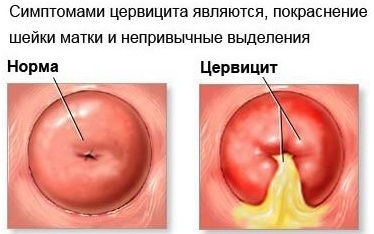Ovarian dysfunction is violation of the activity of the organs of the female reproductive systemresponsible for the development and maturation of oocytes, which occurs under the influence of infectious, endocrine or neuropsychiatric causes.
Since the ovaries are considered part of the hormonal system, their failure can lead to disruption of activity:
- hypothalamus;
- pituitary gland;
- adrenal glands.
Normally, a woman's hypothalamus produces prolactin, which is responsible for the onset of the luteal phase, the exit of the corpus luteum and the normal course of the ovulatory cycle.
In the absence of a hormone or a decrease in its production in a woman's body, anavulation occurs, accompanied by a lack of the onset of the progesterone phase of the menstrual cycle and is characterized by a dangerous, for the female body, an increase in the number estrogen.
Failure in the process of maturation and development of oocytes can go unnoticed for a long time, since its specific signs are not pronounced character and are similar to the symptoms of PMS or the usual seasonal fluctuations in the menstrual cycle:
- anxiety;

- sleep problems;
- constantly changing mood;
- increase or decrease in the days of the menstrual cycle;
Remaining unnoticed, the pathology quickly passes into the next phase, provoking dysfunctional uterine bleeding that appears in the middle of the ovulation cycle.
If untreated, a malfunction of the ovaries can cause a strong failure of the female hormonal background, provoking:
- endometriosis;
- uterine fibroids;
- mastopathy;
- oncology of the mammary glands;
- infertility.
Record content:
- 1 Views
- 2 Stages of the disease
- 3 Symptoms
- 4 Reasons for the appearance
- 5 When to see a doctor
-
6 Diagnostics
- 6.1 Drug treatment
- 6.2 Operative treatment
- 6.3 Traditional methods
- 6.4 Diet
- 7 Prophylaxis
- 8 Forecast
- 9 Ovarian Dysfunction Videos
Views
Ovarian dysfunction is a classification of conditions provoked by a lack of female sex hormones, including:
- ovarian hyperfunction or hypofunction, characterized by a decrease in the work of the ovaries in the production of sex hormones involved in the menstrual chicle;
- too active production of sex hormones by the ovaries;
- a hyperandrogenic state that occurs with an increase in the female body of male steroid hormones, androgens;
- polycystic disease, accompanied by a violation or complete absence of menstruation;

- primary ovarian failure, in which the ovaries completely stop their work by the age of 40;
- unspecified dysfunction;
- ovarian resistance, manifested by primary amenorrhea before the age of 35 years.
Depending on the age, women are distinguished:
| Juvenile dysfunction | It is diagnosed in adolescent girls during the first 2 years after the onset of menstruation. It is accompanied by a violation of the hormonal cycle, lack of ovulation and menstruation caused by:
Clears up on its own over months or years |
| Reproductive dysfunction | It occurs in women who are in the stage of fertility and is accompanied by the absence of a corpus luteum, which causes the arrival of the second phase of the menstrual cycle. Associated with a sharp increase in the body of the hormone estrogen, which is the main cause of the development of hormone-dependent pathologies of the female reproductive sphere |
| Climacteric dysfunction | Appears in the premenopausal period and during menopause and is diagnosed with the absence of menstrual bleeding for 6 months. At the age of a woman over 55 years old, this dysfunction can provoke the development of:
|
Stages of the disease
Depending on the symptoms that appear, the pathology can be divided into several stages:
- The first is characterized by a slight fluctuation in the menstrual cycle, accompanied by crushing or increased duration of bleeding and an unpleasant increase in PMS symptoms.
- In the second, the disease progresses, causing severe pain during menstruation, as well as dysfunctional vaginal bleeding that appears in the middle of the cycle.
- For the third, the absence of menstruation at the reproductive age of more than 6 months is characteristic, accompanied by a strong increase in the amount of estrogen and a complete cessation of ovulation.
Without timely treatment, the disease that has reached the 3rd stage can begin to progress, becoming the cause of the development serious gynecological and endocrine pathologies, as well as cause the appearance of estrogen-dependent oncology and infertility.
Symptoms
Ovarian dysfunction is a pathological condition inherently associated with a violation of the hypothalamus, leading to a change in the course of the menstrual and ovulatory female cycle.
One of the main signs of pathology that occurs at the first stage is a change in the menstrual cycle. Normally, female bleeding occurs once in the interval between 21-35 days and is accompanied by optimal blood loss (150 ml) lasting no more than 6 days.
If the ovaries malfunction, a woman may face:
- with malfunctions of the menstrual cycle in the larger (more than 35 days) or less (less than 21 days) side;
- irregular periods;
- oligomenorrhea, accompanied by scant blood loss;
- polymenorrhea, which occurs during very long (more than 7 days) and unusually heavy menstruation.
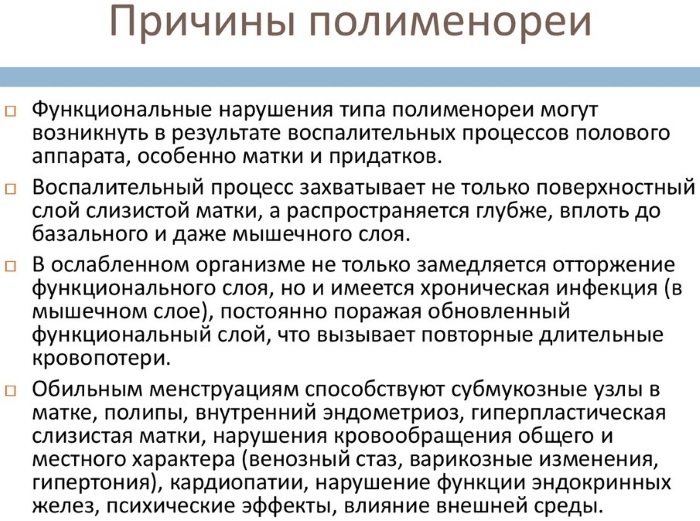
Ovarian dysfunction can cause polymenorrhea.
Large blood loss is most dangerous for the female body, since it leads to iron deficiency anemia, which occurs with a decrease in hemoglobin, and becomes the cause of:
- blanching of mucous membranes and skin;
- brittle hair and nails;
- persistent dizziness;
- severe weakness.
In addition to menstrual irregularities, ovarian dysfunction is manifested:
- Problems with conception caused by a lack of ovulation. If the pregnancy has occurred, that high estrogen level will invariably lead to the death of the embryo.
- Intermenstrual bloody vaginal discharge lasting about 3 days.
- Severe pain in the abdomen and lower back that occurs during menstruation, causing a significant deterioration in the woman's condition.
- Migraines, dizziness, nausea with vomiting occurring during bleeding.
- Increased PMS symptoms, manifested by increased irritability, tearfulness, frequent mood swings.
- Amenorrhea.
- The appearance of severe autonomic disorders that occur in women during menopause.
The absence of menstruation for 6 months in women under the age of 45 who are in the fertile period is the most dangerous and can cause the development of estrogen-dependent oncological conditions, cardiovascular pathologies or psychiatric problems.
Reasons for the appearance
Ovarian dysfunction is a hormonal condition that directly depends on the work of the hypothalamus, pituitary and adrenal glands. The reasons for the development of pathology can be attributed to the work of the reproductive system, the development of viral or infectious pathologies, as well as the neuropsychological state of a woman.
Dysfunction can occur:
| Under the influence of infectious pathologies of the reproductive system |
|
| When diseases of the uterus and ovaries appear |
|
| In case of disruption of the endocrine system caused by |
|
| In case of neuropsychological stress |
|
| Under the influence of external factors |
|
| After medical procedures |
|
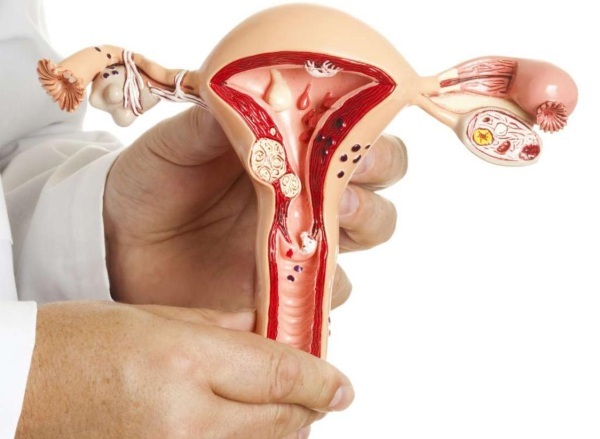
Depending on the type of pathology, and the age of the patient, the dysfunctional state of the ovaries can develop:
| In adolescents | When infectious pathologies appear, the concentration of viruses in which occurs in the pituitary gland of the child (meningitis, rubella) |
| In reproductive age | With an increase in the amount of estrogen |
| In women, after 55 years | With hyperplasia or the appearance of a hormone-dependent tumor in the ovaries |
When to see a doctor
Violation of the menstrual cycle that does not go away for several months is considered the main reason for which a woman should consult a gynecologist. Such an opportunity will make it possible to catch the pathology at an early stage of development and promptly begin corrective treatment.
Concerns should also be raised by:
- intensification and excessive duration of PMS symptoms;
- severe pain, dizziness and migraines accompanying menstrual bleeding;

- intermediate discharge of blood from the vagina, which does not occur while taking hormonal drugs.
These symptoms become a serious condition for a woman to contact a gynecologist for examination and consultation.
Diagnostics
Ovarian dysfunction is diagnosed by a gynecologist after examination and laboratory and X-ray studies. Since this pathology is directly related to the endocrine states of a woman, the patient must also visit the endocrinology office.
During the first appointment, the gynecologist will examine the woman on the armchair, take an anamnesis, specifying the presence of cancer in women or her relatives in the past pathologies, the date of the last menstruation and the symptoms that bother the woman, and also take a smear of cervical mucus for cytological examination.
After examination, the woman will be sent:
- for ultrasound examination of the pelvic organs, thyroid gland and mammary glands;
- for blood tests for formula, biochemistry and hormones;
- on OAM;
- on MRI, CT and X-ray of the brain, which allows to establish the state of the pituitary gland;
- for hysteroscopy of the uterine cervix;
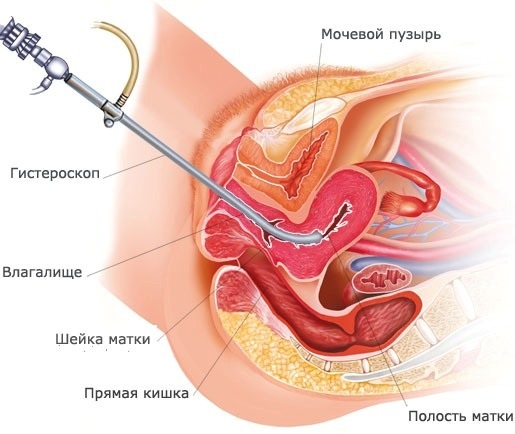
- for analysis for genital infections.
The complete list of studies may vary depending on the condition of the woman.
Treatment of ovarian dysfunction is carried out on an outpatient basis and consists of:
- in stopping bleeding (if necessary);
- in eliminating the causes of the pathology;
- in the normalization of the patient's hormonal background;
- in the restoration of the menstrual cycle.
Therapy is prescribed depending on the cause that caused the violation of the process of maturation and development of eggs:
- when a tumor is detected, surgery or curettage is performed, and then hormone therapy is prescribed;
- if inflammatory processes are detected, a course of antibiotics is carried out;
- with endocrine pathologies, hormonal treatment is performed;
- with immune problems, vitamin and mineral complexes are prescribed;
- for neuropsychological problems, a course of psychotherapy is carried out, and antidepressants are used.
Drug treatment
The main treatment for ovarian dysfunction is carried out with hormonal drugs that help restore the menstrual cycle and prevent bleeding.
Combined hormonal contraceptives (Urozhestan, Tri-merci, Silhouette, Marvelon) are used for 21 days in a capsule daily. Then a 7-day break is taken and COCs are resumed. The duration of treatment can be from 3 to 4 months.
In addition to hormonal drugs, depending on the pathology, the following are prescribed: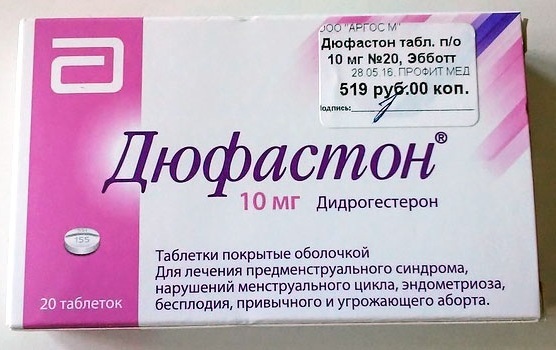
| Duphaston | It is used to increase the amount of progesterone in the blood, which is responsible for the onset of the 2nd, luteal phase, cycle | 10 ml 2-d per day from 16th to 26th day of the cycle |
| Metformin | Helps to normalize metabolism in diabetes mellitus and endocrine pathologies | 1000 ml per day, divided into 2-3 doses (15-30 days) |
| Bromocriptine | Indicated for prolactin-dependent conditions, the drug also helps to cope with polycystic ovary disease and female infertility. | 100 ml per day, divided into 2-3 doses (therapy continues until ovulation is fully restored) |
| Cyproterone | Treats Elevated Male Steroid Hormone Levels in Women | 100 ml each from the 1st to the 10th day of the menstrual cycle |
| Buserelin | Copes with hyperestrogenism | Spray the drug in 150 ml in the nasopharynx every 4-6 hours |
| Spironolactone | Indicated in the treatment of amenoria | The dosage is set individually by the doctor. |
| Sorbifer Durules (Ferrumlex) | Increases hemoglobin levels and fights iron deficiency anemia | 2 tablets per day (3-4 months) |
Operative treatment
Curettage and surgery are prescribed only if the woman has a tumor causing uterine bleeding. In this case, surgery is indicated, and then hormonal therapy, lasting from 4-6 months.
After treatment, the patient should visit a doctor at least once every six months and adhere to a low-calorie diet.
Traditional methods
Herbal decoctions can be taken in the treatment of ovarian dysfunction only as an adjuvant and only after consultation with the doctor.
Normalize hormones and stop bleeding will allow:
| Strawberry leaves | 1 tbsp. l. crushed plant, you need to pour 400 ml of boiling water, insist, filter, and then take it cooled down in 1 s.d. 3 days per day |
| Marigold flowers | 10 g of ground flowers should be steamed with 200 ml of boiled, hot water. The resulting infusion must be defended for about 3 hours, filtered and drunk at 2 tbsp. 3 days per day |
| Viburnum bark | 20 g of cut bark should be poured with 300 ml of water. The mixture should be put on fire and cooked for about 20 minutes. After the specified time has elapsed, the broth must be removed from the stove, insist and drink 3 times a day, 1 tbsp. |
| Borovaya uterus | 100 g of ground grass must be combined with 1.5 liters of water, and then put on fire and boil for 20 minutes. The resulting infusion should be cooled, filtered and drunk 1 tsp. 4 days per day |
| Ruta (helps with lean periods) | 5 g of the plant should be poured with 400 ml of water, put on a small fire and simmer after boiling for about 20 minutes. The finished broth should be filtered, cooled and drunk in the morning. After taking the broth, you can not eat for 5 hours. You can drink the herb once. |
| Horsetail | 1 tsp chopped grass should be poured with 1 liter of water. The infusion must be put on fire and boiled for 15-20 minutes, and then cooled and drunk 1 tbsp each. 3 days per day |
Herbal preparations also help to restore the menstrual cycle:
- 1 tbsp. birch bark, blackberries, yarrow, and buckthorn must be mixed with 200 ml of boiling water. The broth should be infused for 24 hours, and then drunk during the day. You need to take the infusion daily for 3 months.
- It is recommended to take chopped buckthorn, lemon balm, valerian and caterpillar foot in equal quantities (1 tsp each) and combine with 500 ml of very hot water. The resulting broth should be insisted for about 30 hours, passed through cheesecloth, and then drunk 3 times a day for 5 days.

- Taken in 2 tbsp. chopped herbs of sweet clover, meadowsweet, field Yakut, calendula and string should be mixed with 1 liter of water. The infusion must be put on fire, boiled for about 10 minutes, and then taken in the morning and evening from the last day of the previous menstruation, until the first day of the next.
Diet
Diet nutrition is the basis for the correct functioning of the female reproductive system and should include a complete list of all vitamins necessary for women's health and microelements. In the treatment and prevention of pathology, it is especially important to abandon mono-diets and starvation, which can become the development of hormonal disorders.
To maintain women's health, the daily diet should include:
- lean protein products of animal and vegetable origin;
- a variety of vegetables and fruits;
- black bread, cereals, oats;
- egg, milk, fermented milk products;
- vegetable oils;
- seafood;
- nuts.
Prophylaxis
There is no specific prevention of ovarian dysfunction, but to avoid pathology, doctors recommend that women:
- to refuse from bad habits;
- adhere to proper nutrition, making up the daily diet of protein products, a large amount of vegetables and fruits;
- play sports, but not get involved in strength exercises;
- control your weight and avoid obesity, since fat cells provoke an increase in the amount of estrogen in the blood;
- if possible, avoid emotional and mental overload;
- do not neglect medical preventive examinations;
- when having sex, it is imperative to use barrier contraception;

- prevent abortion;
- regularly carry out intimate hygiene.
All infectious and endocrine pathologies found in a woman must be promptly treated to avoid hormonal disruptions.
In particular, women should adhere to the preventive recommendations of the doctor:
- who have not previously become pregnant and have not given birth;
- having bad heredity;
- salivary to unstable emotional states;
- suffering from diseases of the genital area.
Forecast
Ovarian dysfunction is a rather unpleasant pathology, the effectiveness of treatment of which directly depends on the stage of detection of the disease. The pathology diagnosed at an early stage will be completely eliminated and in the future a woman can return to a full-fledged lifestyle, as well as bear and give birth to a healthy child.
If untreated, hormonal dysfunction will progress, leading to estrogen-deficient conditions such as:
- pathological growth of endometrioid tissue;
- uterine myoma;
- oncological processes of the uterus and mammary glands;
- mastopathy;
- infertility.
Ovarian dysfunction is an unpleasant, hormone-dependent condition that causes problems with the maturation and development of female germ cells.
A disease arising under the influence of endocrine, psychological or infectious pathological conditions can cause complete termination of the menstrual cycle and an increase in the blood of estrogens, which are the cause of the development of oncological and endocrine pathologies, as well as infertility.
Ovarian Dysfunction Videos
Doctor about ovarian dysfunction:

